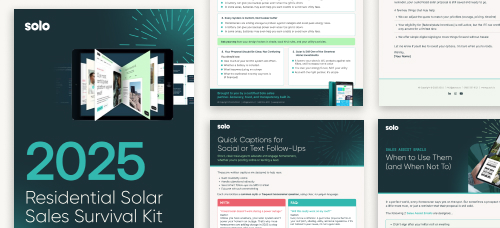Understanding the Objection: It’s About Trust, Not Just Panels

When a homeowner brings up a friend or family member’s bad experience with solar, the concern usually runs deeper than panel performance. It’s a trust issue:
“If they had a terrible time, how do I know I won’t?”
These stories come packed with emotion: frustration, regret, even a sense of betrayal. Maybe it was poor savings. Maybe the installation dragged on for months. Maybe a miscommunication never got resolved. Whatever the reason, the experience stuck. And because it came from someone they trust, the skepticism is harder to move past.
Instead of brushing it off or defending the industry, reps should lean into empath.
Acknowledge the concern. Validate the emotion. Then show up as a clear service-first advisor—not just a salesperson. That’s how trust begins.
Where the Fear Come From
- Outdated systems or unreliable contractors
- Vague financing terms that wasn’t clearly explained
- Installation issues like roof damage or long delays
- No follow-up or communication after the contract was signed
These problems were real. And it’s your job to show how far the industry has come.
Reframing the Narrative: How Solar Has Evolved
Solar today looks very different than it did even five years ago. Stronger regulations, smarter tech, and better workflows have reshaped the experience for homeowners.
1. Regulation Has Caught Up. States like California, Texas, New York, and Florida now have clear rules that protect consumers. Solar reps are required to disclose financing terms. HOAs have less power to block installs. And solar companies are held accountable for what they promise.
In fact, as of 2024, over 50% of U.S. homeowners are covered by solar access protection laws that require transparency and limit unreasonable restrictions.
2. Better Tools Create Better Proposals. Complete software platforms like Solo help reps build accurate, visual proposals that homeowners can actually understand. Savings timelines, panel layouts, and incentive estimates are customized to each roof—so there’s less confusion, and more clarity.
3. Accountability Is Built In. Installers, sales reps, and lenders now operate in shared systems. Everyone sees the same data. Everyone stays aligned.
According to the NREL, shared systems reduce proposal errors by 35% and improve installation timelines by up to 20%.
You’re not just selling solar panels. You’re offering a better, more reliable experience. One that’s rooted in transparency and trust.
Turning the Objection Into a Trust
This isn’t a deal-killer—it’s your chance to stand out.
When someone mentions a bad solar experience, don’t change the subject. Ask questions.
“What went wrong?”
“What was confusing for them?”
“How do you want your experience to be different?”
Then walk them through your process and how it solves for those exact issues.
Use this moment to:
- Show your visuals—layouts, timelines, and projections.
- Offer to walk through paperwork together.
- Share a real customer story or review from someone who has similar concerns.
Don’t dismiss the objection. Disarm it with empathy, transparency, and proof.
Try saying:
“What happened to them shouldn’t have happened. And honestly, that’s why we do things the way we do. Here’s how our process is built to avoid that.”
Stories about bad installs or vague sales tactics are everywhere. But that doesn’t mean your process has to match.
With the right tools, clear documentation, and a service-first approach, solar reps can turn even the most skeptical homeowner into a confident solar customer.


